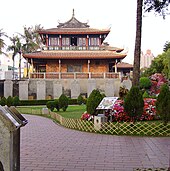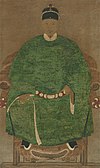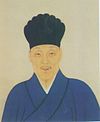Kingdom of Tungning
Kingdom of Tungning | |||||||||||
|---|---|---|---|---|---|---|---|---|---|---|---|
| 1661–1683 | |||||||||||
 Flag | |||||||||||
 Location of the Kingdom of Tungning, and settlements
| |||||||||||
| Capital | Anping City (present-day Tainan) | ||||||||||
| Common languages | Hokkien, Hakka, Formosan languages | ||||||||||
| Government | Monarchy | ||||||||||
| Prince of Yanping | |||||||||||
• 1661–1662 | Koxinga | ||||||||||
• 1662 | (as Lord of Dongdu) | ||||||||||
• 1662–1681 | Zheng Jing | ||||||||||
• 1681 | Zheng Kezang (as Regent) | ||||||||||
• 1681–1683 | Zheng Keshuang | ||||||||||
| History | |||||||||||
• Established | 14 June 1661 | ||||||||||
• Surrender to the Qing | 5 September 1683 | ||||||||||
| Population | |||||||||||
• 1664 | 140,000 | ||||||||||
• 1683 | 200,000 | ||||||||||
| Currency | Silver tael (Spanish dollar) and copper cash coin | ||||||||||
| |||||||||||
| Today part of | Republic of China (Taiwan) | ||||||||||
| Tungning | |||
|---|---|---|---|
| Traditional Chinese | 東寧 | ||
| Simplified Chinese | 东宁 | ||
| Literal meaning | East Peace | ||
| |||
| Zheng dynasty | |||
| Traditional Chinese | 鄭氏王朝 | ||
| Simplified Chinese | 郑氏王朝 | ||
| |||
| Zheng period of the Ming dynasty | |||
| Traditional Chinese | 明鄭時期 | ||
| Simplified Chinese | 明郑时期 | ||
| |||
| History of Taiwan | ||||||||||||||
|---|---|---|---|---|---|---|---|---|---|---|---|---|---|---|
 | ||||||||||||||
| Chronological | ||||||||||||||
|
||||||||||||||
| Topical | ||||||||||||||
| Local | ||||||||||||||
| Lists | ||||||||||||||
|
| ||||||||||||||
The Kingdom of Tungning (Chinese: 東寧王國; pinyin: Dōngníng Wángguó; Pe̍h-ōe-jī: Tang-lêng Ông-kok), also known as Tywan by the British at the time,[1][2][3][4][5] was a dynastic maritime state that ruled part of southwestern Formosa (Taiwan) and Penghu islands between 1661 and 1683, which was regarded as the first predominantly Han Chinese state in Taiwanese history. At its peak the kingdom's maritime power dominated varying extents of coastal regions of southeastern China, and its vast trade network stretching from Japan to Southeast Asia.[6][7][8]
The kingdom was founded by Koxinga (Zheng Chenggong) after seizing control of Taiwan from the Dutch rule. Zheng hoped to restore the Ming dynastic rule on the Chinese mainland, when the Ming remnants' rump state in the southern China was progressively conquered by the Manchu-led Qing dynasty. Zheng dynasts used the newly-owned island as part of the loyalist movement aiming to reclaim the mainland China from the Qing, mainly as a base of military operations but also deepening the process of Sinicization on Taiwan,[9] in an effort to consolidate the last stronghold of Han Chinese resistance against the invading Manchus.[10][11][12] Until its annexation by the Qing dynasty in 1683, the kingdom was ruled by Koxinga's heirs, the House of Koxinga, and the period of rule is sometimes referred to as the Koxinga dynasty.[10]
Names[]
In reference to its reigning dynasty, the Kingdom of Tungning is sometimes known as the Zheng dynasty (Chinese: 鄭氏王朝; pinyin: Zhèngshì Wángcháo; Pe̍h-ōe-jī: Tēⁿ--sī Ông-tiâu), Zheng clan Kingdom (Chinese: 鄭氏王國; pinyin: Zhèngshì Wángguó; Pe̍h-ōe-jī: Tēⁿ--sī Ông-kok) or Yanping Kingdom (Chinese: 延平王國; pinyin: Yánpíng Wángguó; Pe̍h-ōe-jī: Iân-pêng Ông-kok), named after Koxinga's hereditary title of "Prince of Yanping" (Chinese: 延平郡王; pinyin: Yánpíng jùnwáng) that bestowed by the Yongli emperor of the South Ming.[5] Taiwan was referred to by Koxinga as Tungtu (Chinese: 東都; pinyin: Dōngdū; Pe̍h-ōe-jī: Tang-to͘). In Britain, it was known as Tywan (Taiwan),[1][3][4] named after the King's residence at the city of "Tywan" in present-day Tainan.[13][14] The period of rule is sometimes referred to as the Koxinga dynasty.[10]
History[]
Capture of Taiwan and establishment of Zheng Kingdom[]
Following the defeat of the Ming dynasty in 1644, the Manchu Qing offered several high-ranking Ming officials and military leaders positions in the Qing court in exchange for cessation of resistance activities. Zheng Zhilong, a Ming admiral and father of Koxinga, accepted the Qing offer, but was later arrested and executed for not ceding control of his military forces to the Qing cause when asked to do so. After learning of this whilst pursuing studies overseas, Koxinga pledged to assume his father's position and control of his remaining forces in order to re-establish Ming control of China.[15] With most of China controlled by the Qing, Koxinga discovered the situational strategic advantages provided by a retreat and occupation of Taiwan from the translator who was working for the Dutch East India Company.[16] Supplied by Ho-Bin with maps of the island, Koxinga marshalled his forces, estimated at 400 ships and 25,000 soldiers, and seized the Pescadores (also known as Penghu Islands) so as to utilize them as a strategic staging point from which to invade Taiwan, at the time controlled by the Dutch.[15]

In 1661, Koxinga's fleet forced an entry to and made landing around Fort Provintia. In less than a year, he captured Fort Provintia and besieged Fort Zeelandia; with no external help coming, Frederick Coyett, the Dutch governor negotiated a treaty,[17] where the Dutch surrendered the fortress and left all the goods and property of the Dutch East India Company behind. In return, most Dutch officials, soldiers and civilians were allowed to leave with their personal belongings and supplies and return to Batavia (present-day Jakarta, Indonesia), ending the 38 years of Dutch colonial rule on Taiwan. Koxinga did, however, detain some Dutch "women, children, and priests" as prisoners.[18] He then proceeded on a tour of inspection with a contingent of nearly 100,000 soldiers to "see with his own eyes the extent and condition of his new domain."[19]
Realizing that developing his forces in Taiwan into a large enough threat to unseat the Qing would not be achieved in the short term, Koxinga began transforming Taiwan into a practically proper, albeit preferably temporary, seat of power for the southern Ming loyalist movement. Replacing the Dutch system of government previously used in Taiwan, Koxinga instituted a Ming-style administration, the first Chinese governance in Taiwan. This system of government was divided into six departments: civil service, revenue, rites, war, punishment, and public works.[15] Great care was taken to symbolise support for the Ming legitimacy, an example being the use of the term guan instead of bu to name departments, since the latter is reserved for central government, whereas Taiwan was to be a regional office of the rightful Ming rule of China.[20] Zheng Jing dutifully complied with the prescribed procedures for Ming officials by regularly presenting reports and paying tribute to the absent Ming Emperor.[21] Formosa (Taiwan) was also renamed by Koxinga as Tungtu, though this name was later changed by his son, Zheng Jing, to Tungning.[22]
Development[]

The most immediate problem Koxinga faced after the successful invasion of Taiwan was a severe shortage of food. It is estimated that prior to Koxinga's invasion the population of Taiwan was no greater than 100,000 people, yet the initial Zheng army with family and retainers that settled in Taiwan is estimated to be 30,000 at minimum.[15] To address the food shortage, Koxinga instituted a tuntian policy in which soldiers served the dual role of farmer when not assigned active duty in a guard battalion. No effort was spared to ensure the successful implementation of this policy to develop Taiwan into a self-sufficient island, and a series of land and taxation policies were established to encourage the expansion and cultivation of fertile lands for increased food production capabilities.[20] Lands held by the Dutch were immediately reclaimed and ownership distributed amongst Koxinga's trusted staff and relatives to be rented out to peasant farmers, whilst properly developing other farmlands in the south and the claiming, clearing, cultivating and of Aborigine lands to the east was also aggressively pursued.[15] To further encourage expansion into new farmlands, a policy of varying taxation was implemented wherein fertile land newly claimed for the Zheng regime would be taxed at a much lower rate than those reclaimed from the Dutch, considered "official land".[20]
Koxinga, at one point, declared his intention to conquer the Philippines in retaliation for the Spanish mistreatment of the Chinese settlers there.[23] His originally stated intentions for conquering Taiwan from the Dutch also included the desire to protect Chinese settlers in Taiwan from maltreatment by the Dutch.[24]
Following the death of Koxinga in 1662 due to malaria, his son Zheng Jing took over the Zheng regime, leading the remaining 7,000 Ming loyalist troops to Taiwan.[15] Differing from Koxinga, it seems Jing attempted to reconcile peacefully with the Qing by travelling to Peking and bidding for Taiwan to become an autonomous state, but refusing to accept the conditions of compulsory Manchu hairstyle and regular tributes of currency and soldiers. In response to raids by Zheng Jing and in an effort to starve out the forces in Taiwan, the Qing decreed to relocate all of the southern coastal towns and ports that had been the targets of raids by the Zheng fleet and thus provided supplies for the resistance. This to a large extent backfired and from 1662 to 1664 six major waves of immigration occurred from these areas to Taiwan due to the severe hardships incurred from this relocation policy. In a move to take advantage of this Qing misstep, Zheng Jing promoted immigration to Taiwan by promising the opportunity for free eastern land cultivation and ownership for peasants in exchange for compulsory military service by all males in case the island should need to be defended against Qing invaders. About 1,000 previous Ming government officials moved to Taiwan fleeing Qing persecution.[20]
Zheng Jing also recruited his early tutor, Chen Yong-hua, and passed to him most official government affairs. This saw the establishment of many important developmental policies for Taiwan in education, agriculture, trade, industry and finance, in addition to a tax system almost as harsh as that of the Dutch colonials.[15] Taiwan soon saw the establishment of Chinese language schools for both the Chinese and indigenous populations and a concerted effort to break Dutch and Indigenous religious, language, and other cultural influences, and promotion of Chinese socio-cultural hegemony along with further expansion of towns and farmland into the south and east.[20] This was realised in the eventual closure of all European and therefore Christian schools and churches in Taiwan, the opening of Confucian temples and the institution of the Confucian civil service exams to coincide with the implemented Confucian education system. Chen Yong-hua is credited for the introduction of new agricultural techniques, such as water-storage for annual dry periods and the deliberate cultivation of sugar cane as a cash crop for trade with the Europeans, in addition to the cooperative unit machinery for mass refining of sugar. The island became more economically self-sufficient with Chen's introduction of mass salt drying by evaporation, creating much higher quality salt than by rock deposits which were found to be very rare in Taiwan.[20] The Dutch had previously maintained a monopoly of trade of certain goods with the Aboriginal tribes across Taiwan, and this monopoly of trade was not only maintained under the Zheng regime, but was actively turned into a quota-tribute system of exploitation of the native tribes to aid in international trade.[20] Trade with the British occurred from 1670 through until the end of the Zheng regime, though for the most part limited because of the Zheng monopoly on sugar cane and deer hide, as well as the inability of the British to match the price of East Asian goods for resale. Throughout its existence, Tungning was subject to the Qing sea ban (haijin), limiting its trade with mainland China to smugglers. Aside from the British, Zheng major trade occurred with the Japanese and Dutch, though evidence of trade with many Asian countries exists.[20]
Zheng Jing's navy defeated a combined Qing-Dutch fleet commanded by Han Banner General Ma Degong in 1664 and Ma Degong was killed in the battle by Zheng's fleet.
The Dutch looted relics and killed monks after attacking a Buddhist complex at Putuoshan on the Zhoushan islands in 1665 during their war against Zheng Chenggong's son Zheng Jing.[25]
Zheng Jing's navy executed thirty four Dutch sailors and drowned eight Dutch sailors after ambushing, looting and sinking the Dutch fluyt ship Cuylenburg in 1672 on northeastern Taiwan. Only twenty one Dutch sailors escaped to Japan. The ship was going from Nagasaki to Batavia on a trade mission.[26]
On a constant war footing, and denied maritime trade by the hostile Dutch-Qing alliance, the Kingdom of Tungning intensively exploited these lands to feed their vast army. This resulted in a number of brutally suppressed rebellions by the indigenous population and a gradual weakening of the competing Kingdom of Middag.[27]
A series of major conflicts between the Kingdom of Tungning and the Saisiyat people left the Saisiyat decimated and with much of their land in the hands of the Kingdom. The details of the conflicts remain mysterious however historians agree that the outcome was negative for the Saisiyat.[28]
Death of Zheng Jing and Qing invasion[]
Following the death of Zheng Jing in 1681, the lack of an official heir meant rule of Taiwan would pass to his illegitimate son. This caused great division in the government and military powers, resulting in an exceptionally destructive struggle for the succession. Seizing the advantage presented by the infighting, the Qing dispatched their navy with Shi Lang at its head, destroying the Zheng fleet at the Penghu Islands. In 1683, after the Battle of Penghu, Qing troops landed in Taiwan, Zheng Keshuang gave in to the Qing Dynasty's demand for surrender, and his kingdom was incorporated into the Qing Dynasty as part of Fujian province, ending two decades of rule by the Zheng family.[29]
Several Ming dynasty Princes had accompanied Koxinga to Taiwan including the Prince of Ningjing Zhu Shugui and Prince , son of Zhu Yihai. The Qing sent the 17 Ming princes still living on Taiwan back to mainland China where they spent the rest of their lives.[30]
Zheng Keshuang was taken to Beijing, where he was ennobled by the Qing Emperor as "Duke of Hanjun" (漢軍公); together with his family and leading officers, he was also inducted into the Eight Banners. Junior members of the House of Koxinga acquired the hereditary style of Sia (舍).[31]
Troops who specialized at fighting with rattan shields and swords (Tengpaiying) 藤牌營 were recommended to the Kangxi Emperor. Kangxi was impressed by a demonstration of their techniques and ordered 500 of them to reinforce the siege of Albazin against the Russians, under Ho Yu, a former Koxinga follower, and Lin Hsing-chu, a former General of Wu. Attacking from the water using only the rattan shields and swords, these troops cut down Russian forces traveling by rafts on the river, without suffering a single casualty.[32][33][34][35]
Rulers[]
| No. | Portrait | Name (Birth–Death) |
Title(s) | Reign (Lunar calendar) | |
|---|---|---|---|---|---|
| 1 | 
|
Koxinga (Zheng Chenggong) 鄭成功 Zhèng Chénggōng (Mandarin) Tēⁿ Sêng-kong (Hokkien) Chhang Sṳ̀n-kûng (Hakka) (1624–1662) |
Prince of Yanping (延平王) Prince Wu of Chao (潮武王) |
14 June 1661 Yongli 15-5-18 |
23 June 1662 Yongli 16-5-8 |
| 2 | 
|
Zheng Xi 鄭襲 Zhèng Xí (Mandarin) Tēⁿ Si̍p (Hokkien) Chhang Si̍p (Hakka) (1625–?) |
Protector (護理) | 23 June 1662 Yongli 16-5-8 |
November 1662 Yongli 17 |
| 3 | 
|
Zheng Jing 鄭經 Zhèng Jīng (Mandarin) Tēⁿ Keng (Hokkien) Chhang Kîn (Hakka) (1642–1681) |
Prince of Yanping (延平王) Prince Wen of Chao (潮文王) |
November 1662 Yongli 17 |
17 March 1681 Yongli 35-1-28 |
| 4 | 
|
Zheng Kezang 鄭克 | |||
